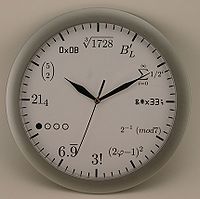Lecture 2
Readings For This Lecture
Keshet Course Notes:
- Chapter 1, pages 1 to 13 (up to subsection 1.6)
Summary
When one wants to sum up a large set of numbers, it helps to have some sort of notation that cleans up something like  .
.
This notation would be what is called sigma, or summation notation. For the sum stated above, the notation would be 
The number below the sigma (k=1) is called the "index of summation" and it represents what term the sum is starting from, in this case, it is the first term.
The superscript, or whatever is above the sigma shows at what point the summation stops.
Suppose that we want to sum up five 1s, or  . To put this into sigma notation we would write
. To put this into sigma notation we would write  . This is because we want the sum of term 1 through 5 of a formula, "1". This sum, of course, would just lead to the number 5.
. This is because we want the sum of term 1 through 5 of a formula, "1". This sum, of course, would just lead to the number 5.
The general formula for this would be 
This fact can also lead to the very useful fact that, if what you are summing up has a common factor in it, you can bring that factor out of the notation and multiply it to the sum after it is found. e.g. 
Lets now take a look at how combine similar sums.  which is really just
which is really just  .
.
Another way of simplifying sums is to expand. When you have a sum of two terms being added or subtracted (e.g.  ) you can split each part into it's own sum.
) you can split each part into it's own sum.
In this case, that would mean  .
.
There are a few formulae for actually determining sums from the summation notation.
The first one we will look at is Gauss' formula which will aid us in determining the sum of  which can also be written as
which can also be written as 
If we add this series to itself flipped around, we would get

+


Which means there are N terms of  so
so  which means
which means 
This conclusion that was just reached is Gauss' formula: 
There are also formulae for adding up N terms of  and
and 
These are:

and

Exercises
Reference the appropriate formula from the course formula sheet when required.
1. Write  in summation notation.
in summation notation.
| Solution
|

|
2. Write  in summation notation.
in summation notation.
| Solution
|

|
3. Simplify  .
.
| Solution
|

|
4. Simplify  .
.
| Solution
|

|
5. Show that the sequences  and
and  are equivalent.
are equivalent.
6. Compute the sum  .
.
| Solution
|
Using the fact that 

|
7. Compute the sum  .
.
| Solution
|
This uses the facts that  and and  . We can first expand the sum to include the first term and subtract it in a further step, . We can first expand the sum to include the first term and subtract it in a further step,  . This then can be expanded and simplified to . This then can be expanded and simplified to  This, when put into the proper formulae comes out to This, when put into the proper formulae comes out to 
|
8. Find the sum of the first 50 odd integers,  .
.
| Solution
|
Using the fact that 

|
9. Compute the following sum:  .
.
10. A triangular pyramid of spheres has one sphere on the top layer, 2+1 = 3 spheres on the second layer, 3+2+1=6 spheres on the third layer, and so on. Write down a formula for the number of spheres needed for a pyramid that is  layers deep. How many spheres are needed for a pyramid that is 100 layers deep?
layers deep. How many spheres are needed for a pyramid that is 100 layers deep?
| Solution
|
This uses  and and 
Formula: 
For a pyramid 100 layers deep, we plug the proper values into the formulae and get:
 spheres are needed. spheres are needed.
|
























































